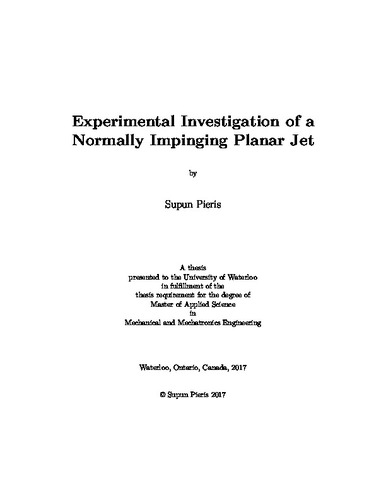| dc.description.abstract | Impinging jets are commonly employed in engineering applications, such as cooling and drying processes, requiring relatively high local transport properties. Flow development of a planar impinging jet and the effect of varying jet parameters are investigated experimentally in a jet facility that is specifically designed, fabricated, and characterized as part of the
current study. The velocity field is measured using time-resolved, planar, two-component Particle Image Velocimetry. The investigation focuses on two jet parameters: Reynolds number and nozzle-to-plate spacing. Four test cases are investigated, including two Reynolds numbers 3000 and 6000, and two nozzle-to-plate spacings, 2B and 4B, where B is the jet
width. Primary vortices form in the shear layer just downstream of the nozzle exit due to amplification of disturbances through the Kelvin-Helmholtz instability. Vortex shedding exhibits higher periodicity with increasing Reynolds number but is not significantly affected by changes to the nozzle-to-plate spacing. Further, vortex shedding location shifts upstream with increasing Reynolds number. The Strouhal number based on vortex shedding frequency varies between 0.4-0.5 and the vortices are convected downstream at an average convective velocity of 57% of the jet centerline velocity for all cases examined. For Reynolds number of 6000, the characteristic wavelength of the primary vortices is 1.1B for both nozzle-to-plate spacings. At the lower Reynolds number, the wavelengths increase to approximately 1.3B and 1.5B, for nozzle-to-plate spacings of 2B and 4B, respectively. Local deceleration of primary vortices, due to the impinging surface, causes consecutively shed vortices to merge, with vortex merging observed in all cases investigated. As the primary vortices pass in the outer shear layer of the wall jet region, secondary vortices of opposingly signed vorticity form due to roll-up of the wall bound vorticity in the inner shear layer. The secondary vortex shedding is marked by amplification of the surface normal velocity fluctuations in the inner shear layer when x/B > 3. The secondary vortex shedding shows a lower periodicity compared to the primary vortices but in general have convective velocities that are larger than that of the primary vortices. As the Reynolds number is increased, the secondary vortex formation is suppressed, and, as a result, the wall jet develops more parallel to the impinging surface. With increasing Reynolds number, the
convective velocities of the secondary vortices also decrease. In all cases, pairing between a primary and secondary vortex is observed and the paired vortices are convected in the streamwise direction away from the surface. At the higher Reynolds number, the pairing is immediately followed by vortex breakdown. | en |

